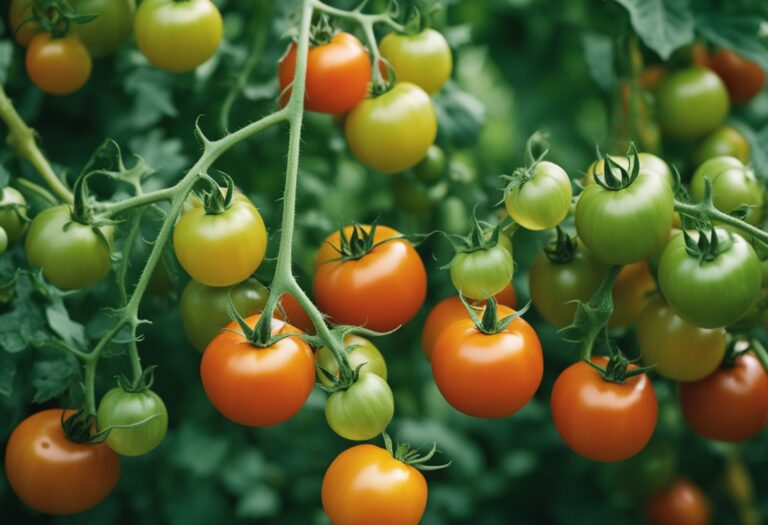Tomato Stem Turning Brown: Causes and Solutions
If you’re a gardener, you know how frustrating it can be to see your tomato plants not thriving as they should. One common problem is the stem turning brown. This can be caused by a number of different factors, from diseases to environmental conditions. In this article, we’ll explore the causes of tomato stem browning and what you can do to prevent and treat it.
Understanding Tomato Stem Browning is key to preventing it from happening to your plants. Brown stems can be a sign of disease, but they can also be caused by other factors such as overwatering or underwatering, nutrient deficiencies, or physical damage. By understanding the underlying causes of stem browning, you can take steps to prevent it from happening in the first place.
Common Causes of Stem Browning include fungal diseases like Fusarium wilt and Verticillium wilt, as well as bacterial canker and stem rot. Environmental factors like drought, excessive heat, and cold temperatures can also cause brown stems. In the next section, we’ll explore these causes in more detail and provide tips on how to prevent and treat them.
Key Takeaways
- Understanding the causes of tomato stem browning is key to preventing it from happening to your plants.
- Common causes of stem browning include fungal diseases, bacterial canker, and environmental factors like drought and extreme temperatures.
- Preventative measures include proper planting and watering techniques, removing diseased plants, and maintaining a healthy growing environment.
Understanding Tomato Stem Browning
Tomato plants are a popular choice for home gardeners, but they can be susceptible to a variety of problems. One of the most common issues is stem browning. If you notice your tomato plant’s stem turning brown, there are a few things you should know.
First, it’s important to understand that stem browning can be caused by a variety of factors. Nutrient deficiencies, pests, diseases, and environmental factors can all contribute to the problem. In some cases, it may be a combination of these factors.
To determine the cause of the problem, it’s important to examine the plant closely. Look for signs of pests or disease, such as spots on the leaves or discoloration of the stem. Check the soil to make sure it’s not too dry or waterlogged. Consider whether the plant is getting enough sunlight or if it’s being exposed to extreme temperatures.
If you’re not sure what’s causing the problem, it’s best to consult with a gardening expert. They can help you identify the problem and recommend the best course of action. In some cases, you may need to adjust your watering or fertilization schedule, while in others, you may need to treat the plant with a pesticide or fungicide.
Remember, early detection and treatment are key to preventing serious damage to your tomato plants. By staying vigilant and taking action at the first sign of trouble, you can help ensure a healthy and productive harvest.
Common Causes of Stem Browning
If you’re experiencing brown stems on your tomato plants, there are several possible causes. In this section, we will discuss the most common causes of stem browning and what you can do to prevent it.
Environmental Stress
Environmental stress can cause tomato stems to turn brown. This can be caused by extreme temperatures, drought, or overwatering.
To prevent environmental stress, make sure your tomato plants are getting the right amount of water and are not exposed to extreme temperatures. Additionally, you can add mulch to help retain moisture in the soil.
Pest Infestations
Pests such as aphids, spider mites, and whiteflies can cause stem browning on tomato plants. These pests feed on the sap of the plant, which can cause the stem to turn brown and weaken.
To prevent pest infestations, regularly inspect your plants and remove any pests you find. You can also use insecticidal soap or neem oil to control pests.
Diseases and Fungal Infections
Diseases such as bacterial canker, blight, and wilt can cause tomato stems to turn brown. These diseases are caused by bacteria or fungi, which can infect the plant through wounds or through the soil.
To prevent diseases and fungal infections, make sure your plants are properly spaced and avoid overwatering. Additionally, you can use fungicides to control the spread of these diseases.
Nutrient Deficiencies
Nutrient deficiencies can also cause tomato stems to turn brown. This is often caused by a lack of calcium or magnesium in the soil. To prevent nutrient deficiencies, make sure your soil is properly fertilized and has the right balance of nutrients. You can also add calcium or magnesium supplements to the soil to prevent deficiencies.
Remember, prevention is key when it comes to stem browning on tomato plants. By following these tips and properly caring for your plants, you can prevent stem browning and enjoy a healthy harvest.
Preventative Measures and Solutions
If you notice that your tomato plant’s stem is turning brown, there are several preventative measures and solutions you can take to address the issue and ensure the health of your plant.
Proper Watering Techniques
One of the most common reasons for brown stems in tomato plants is improper watering techniques. To ensure your plant is receiving the appropriate amount of water, be sure to water slowly, deeply, and frequently. This is especially important when the plant is establishing itself.
However, even when your plant is strong and seemingly healthy, you should keep up with this habit. Be sure to water the soil and not the leaves or stem to prevent stem rot.
Soil Quality and Composition
The quality and composition of your soil can also play a significant role in the health of your tomato plant. Be sure to use well-draining soil that is rich in nutrients. You can also add compost or other organic material to improve the soil quality and provide additional nutrients to your plant.
Adequate Spacing and Airflow
Proper spacing and airflow can also help prevent brown stems in tomato plants. Be sure to space your plants appropriately and prune them regularly to promote airflow. This can help prevent the growth of harmful bacteria and fungi that can cause stem rot.
Regular Monitoring and Maintenance
Finally, regular monitoring and maintenance are essential for the health of your tomato plant. Be sure to inspect your plant regularly for signs of brown stems or other issues. If you notice any problems, take action immediately to address them. This can include removing infected leaves or stems, improving watering techniques, or adjusting the soil composition.
By following these preventative measures and solutions, you can help ensure the health and vitality of your tomato plant and prevent brown stems from developing.
Treatment of Brown Stems
If you’ve noticed that your tomato plant’s stem is turning brown, it’s time to take action to help save your plant. Here are some treatments you can try to help your tomato plant recover.
Identifying the Problem
Before you can treat your tomato plant, you need to identify the problem. Brown stems can be a symptom of several issues, including bacterial canker, stem rot, or verticillium wilt. You can use the Visual Guide: Tomato Foliage, Stem & Root Problems to help identify the problem.
Natural Remedies
If you prefer natural remedies, there are a few options you can try. First, remove any infected leaves or stems and dispose of them. Next, apply a solution of 1 tablespoon of baking soda and 1/2 teaspoon of vegetable oil mixed into 1 gallon of water to the base of the plant. This can help prevent the spread of disease.
Another natural remedy is to apply a solution of 1 tablespoon of hydrogen peroxide mixed into 1 gallon of water to the base of the plant. This can help kill bacteria and fungus.
Chemical Treatments
If natural remedies don’t work, you may need to turn to chemical treatments. Copper fungicides can be effective against bacterial canker and stem rot. Follow the instructions carefully and apply the fungicide to the base of the plant.
For verticillium wilt, there are no chemical treatments available. The best course of action is to remove the infected plant and avoid planting tomatoes in the same location for several years.
Remember to always follow the instructions carefully when using chemical treatments and wear protective gear, such as gloves and a mask.
When to Seek Professional Help
If you have tried all the recommended solutions and your tomato plant’s stem is still turning brown, it may be time to seek professional help. Here are some signs that indicate you need to call a professional:
- Widespread browning: If the browning is widespread and affecting most of the plant, it may be a sign of a serious disease or pest infestation. A professional can diagnose the problem and recommend the best course of action.
- Stunted growth: If your plant has stopped growing or has become stunted, it may be a sign of a nutrient deficiency or a pest infestation. A professional can help identify the issue and provide a solution.
- No improvement: If you have tried all the recommended solutions, but the problem persists, it may be time to call in a professional. They can provide a more in-depth analysis of the problem and recommend the best course of action.
Remember, early intervention is key to saving your tomato plant. Don’t hesitate to seek professional help if you notice any of these signs.
Frequently Asked Questions
What can be done to treat stem canker in tomato plants?
If you notice dark brown or black sunken areas on the stem of your tomato plant, it may be suffering from stem canker. Unfortunately, there is no cure for stem canker, and infected plants should be removed and destroyed immediately. To prevent the spread of the disease, do not plant tomatoes in the same area for at least three years.
How can I identify and manage tomato stem rot?
Tomato stem rot is caused by a fungal infection and can cause the stem of the plant to turn brown and mushy. To manage the disease, remove infected plants immediately and avoid planting tomatoes in the same area for at least two years. You can also prevent the disease by providing adequate drainage, avoiding overhead watering, and keeping the area around the plant clean.
Are tomato plants with mold on their stems safe to consume?
Tomato plants with mold on their stems are not safe to consume. The mold can produce mycotoxins, which can be harmful to humans and animals. If you notice mold on your tomato plant, remove and destroy the infected plant immediately.
What might be causing large bumps to appear on my tomato stem?
Large bumps on tomato stems are actually roots, and they are completely normal. However, if you notice bumps that are soft or discolored, it may be a sign of a fungal or bacterial infection. Remove infected plants immediately to prevent the spread of the disease.
Is it possible for tomato plants to recover from stem rot?
Unfortunately, tomato plants cannot recover from stem rot. Infected plants should be removed and destroyed immediately to prevent the spread of the disease. To prevent stem rot from occurring in the first place, avoid overhead watering, provide adequate drainage, and avoid planting tomatoes in the same area for at least two years.
How do I prevent my tomato plants from developing blight?
To prevent blight in tomato plants, provide adequate spacing between plants, avoid overhead watering, and keep the area around the plant clean. You can also use disease-resistant varieties and rotate crops to prevent the disease from taking hold. If you notice signs of blight, remove infected plants immediately to prevent the spread of the disease.


